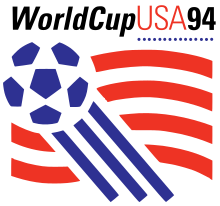| World Cup USA '94 | |
|---|---|
 Making Soccer History | |
| Tournament details | |
| Host country | United States |
| Dates | June 17 – July 17 |
| Teams | 24 (from 5 confederations) |
| Venue(s) | 9 (in 9 host cities) |
| Final positions | |
| Champions | |
| Runners-up | |
| Third place | |
| Fourth place | |
| Tournament statistics | |
| Matches played | 52 |
| Goals scored | 141 (2.71 per match) |
| Attendance | 3,597,042 (69,174 per match) |
| Top scorer(s) | (6 goals each) |
| Best player(s) | |
| Best young player | |
| Best goalkeeper | |
| Fair play award | |
← 1990 1998 → | |
The 1994 FIFA World Cup was the 15th FIFA World Cup, the world championship for men's national soccer teams. It was hosted by the United States and took place from June 17 to July 17, 1994, at nine venues across the country. The United States was chosen as the host by FIFA on July 4, 1988.[1] Despite soccer's relative lack of popularity in the host nation, the tournament was the most financially successful[2][3] in World Cup history. It broke tournament records with overall attendance of 3,587,538 and an average of 68,991 per game,[4] figures that stand unsurpassed as of 2022,[5] despite the expansion of the competition from 24 to 32 teams starting with the 1998 World Cup.[6]
Brazil was crowned the winner after defeating Italy 3–2 in a penalty shootout at the Rose Bowl in Pasadena, California, near Los Angeles, after the game had ended 0–0 after extra time. It was the first World Cup final to be decided on penalties. The victory made Brazil the first nation to win four World Cup titles. There were three new entrants in the tournament: Greece, Nigeria, and Saudi Arabia; Russia also appeared as a separate nation for the first time, following the breakup of the Soviet Union, and for the first time since 1938, a unified Germany took part in the tournament. It was also the defending champion, but was eliminated in the quarterfinals by Bulgaria. It was the first World Cup where three points were awarded for a victory instead of two and also the first with the back-pass rule. This was done to encourage a more attacking style of soccer as a response to the criticism of the defensive tactics and low-scoring matches of the 1990 World Cup. This resulted in an average of 2.71 goals per match, compared to 2.21 in 1990.
- ^ "FIFA World Cup™ Host Announcement" (PDF). FIFA. Archived from the original (PDF) on January 17, 2012.
- ^ "World Cup Moments, 1994: Penalties decide low key but financially successful American tournament". The Malta Independent.
- ^ McMullen, Paul (July 19, 1994). "U.S. Cup brimming with profits WORLD CUP 1994". Baltimore Sun.
- ^ Brewin, John; Williamson, Martin (April 30, 2014). "World Cup History: 1994". ESPN.com. Retrieved June 25, 2020.
- ^ "FIFA World Cup comparative statistics 1982-2014" (PDF). FIFA. Archived (PDF) from the original on July 16, 2021. Retrieved June 25, 2020.
- ^ Das, Andrew (April 8, 2017). "U.S., Mexico and Canada Likely to Affirm Joint World Cup Bid". The New York Times. Retrieved June 25, 2020.